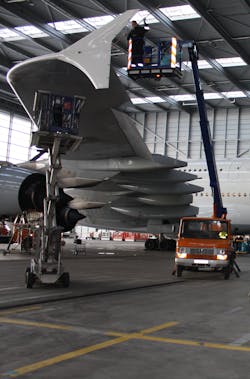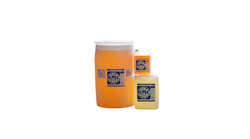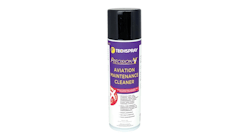Any aircraft maintenance technician has experienced the tough challenge of removing hardened belly soils which may include any or all of the following: hydraulic fluids, aviation fuels, galley and head waste, exhaust soot, grease lubricants, peroxides, waste rubber and ambient air contaminants such as pollens, diesel fuel exhaust, airborne aerosols of industrial solvents, salt water moisture, paints, adhesives, acids, corrosive detergents, power generation exhausts, and earth soils.
While salt water vapor combining with oxygen in the atmosphere is known to produce the main source of corrosion in aircraft, the accumulated belly soils act to entrap these corrosive soils and worsen their attack on aircraft structures.
Any airframe with several hours of accumulated flight time will likely exhibit all of these materials which adhere firmly to painted and unpainted surfaces and help to exacerbate the corrosive effects of atmosphere on a pressurized fuselage and the entire airframe. These materials, both acid and alkaline in nature, will also interact with fasteners, seals, gaskets, hoses, wiring and together with the cumulative effect of airborne grit will cause virtually all flight surfaces to gradually and continuously degrade the airworthiness of the aircraft. While most of the discussion for the cleaning removal of these soils from the belly of an aircraft will also apply to the rest of the aircraft, the belly is of particular concern because the soils tend to be much more difficult to remove, that being the location of most engine exhausts, wheel lubricants and the host of internal cabin wastes that are discharged during flight.
The most common agents causing direct chemical attack on aircraft are: spilled battery acid or fumes from batteries; residual flux deposits resulting from inadequately cleaned, welded, brazed, or soldered joints; and entrapped caustic cleaning solutions. The combined effect of warm, dry air laminar flow, the effect of high-pressure airflow over a given flight surface, will gradually cause such soils to adhere with a super-adhesive tenacity that defeats most any light-duty spray-and-wipe cleaning alternative including traditional petroleum hydrocarbon solvents, aggressive salt based detergents and most organic cleaners as well. These tough soils have heretofore been removed with nonwoven abrasive pads and a variety of salt-based corrosive cleaners. In general the types of cleaning agents used on aircraft are solvents (both evaporative and non-evaporative and miscible and immiscible types), emulsion cleaners, soaps, and synthetic detergents. Typically, an alkaline cleaner would then be followed with a rinse and then a neutralizer to achieve a neutral finish and protect against corrosive degradation of the surface, lap joints, adhesives and rivet bedding.
With the advent of newer alkaline, colloidal micelle, aqueous biobased oleosurfactants, typically non-ionic in nature, dating after 1990, the aircraft cleaning process, especially for removing belly soils, has finally eliminated the need for one of the primary sources of corrosion damage, that is sodium based or detergent cleaning agents (which react with surfaces to remove soils). This new family of biobased cleaners are typically non-reactive to aviation metals, paints, rubberoids, vinyl, plastics, glass, and any material that is compatible with water. Comprised of seed oils of soy, corn, palm oil, and some other refined seed oils such as cotton seed and safflower, they typically have higher Hydrophilic Lipophilc Balance (HLB) numbers exceeding 13 or 14 in favor of water phase interface while displacing oil phase soils in a water solution. Because of their extreme hydrophilic attraction, they generally have little or no long-term emulsion forming ability and will not compromise downstream oil/water separators and instead will improve separation efficiency.
These products auto disperse and will remain fully stabile in a water solution. Best performance is usually achieved at a solution temperature exceeding 90 F followed with a warm water rinse. Experience has consistently shown that using oleosurfactants in aviation cleaning will save time, money and effort while maintaining a clean flight surface and reducing or nearly eliminating corrosive degradation. Typically, oleosurfactants will be non-reactive with other chemicals used in aircraft maintenance today. These products are generally very safe to handle, store and transport and are typically used at 3 to 10 percent of water solution for most soil types. They are generally applied with a power sprayer and provide a moderate foam to better monitor their application before dissipating. Dwell time is typically one to five minutes with light scrubbing with a nylon brush or fabric mop head before an all over rinse.
Where belly soils require a solvent to be removed completely such as, tars, hydraulic lubricant, tire waste, or caffeine smears, the use of an aviation approved soy methyl ester that will, in turn, be removed with the aqueous biobased cleaner before rinsing. One such example is the SAFE CARE® SC-Aircraft & Metal Cleaner® offered by GEMTEK in Phoenix, AZ. Apart from removing aviation engine exhaust soot and hydraulic fluids and other typical belly soils, SC-Aircraft offers protection against continuing corrosion on flight surfaces as a natural anti-oxidant, the result of its seed oil formulary. Together with SC-EZSolv®, (usually a 80/20 blend that is reduced to a 10% solution for cleaning when combined together) the two products offer a combined one-two punch for belly soils proven in both military and commercial aviation. Both products comply with current Boeing, Airbus, and Bombardier exterior cleaning certifications and have Mil-Spec, Biopreferred, WHIMS, REACH, AQIS, and SCAQMD listings.
As with most aviation cleaning applications, the toughest soils inside the wheel wells, at the rear of the engine exhaust and tail end of the fuselage belly are treated first before all over cleaning is underway. A thorough water rinse from the top down to remove light surface soils followed by a 3% to 10% solution of biobased aqueous cleaner with or without the solvent enhancement. The use of the newer biobased alternative chemicals to traditional aircraft belly cleaning offers important improvements in cleaning performance without any sacrifice in performance or value. Additional information is available from the USEPA at www.epa.gov/ozone/snap/icel/aircraf2.pdf.
Kim C. Kristoff is the president of GEMTEK, Phoenix, AZ, a leading biobased chemical manufacturer specializing in seed oil derived surfactants, solvents, lubricants, and specialty chemicals for industry and transportation applications including aviation. Kristoff has been a biobased industry consultant, member of several state and federal biobased advisory committees, and a contributing author to technical journals in North America. For more inforamtion visit www.gemtek.com.





